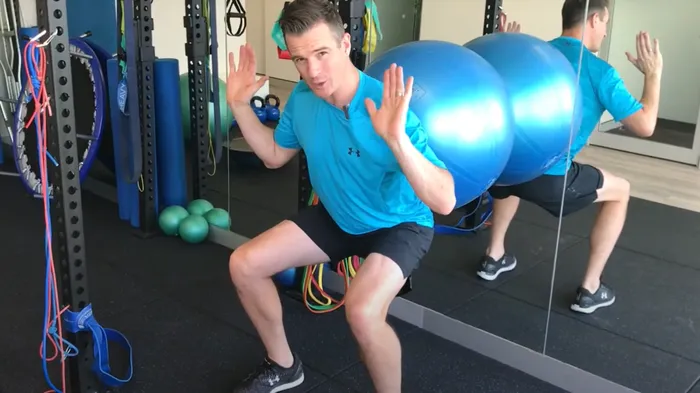Lower body strength is crucial for maintaining proper posture, balance, and range of motion. A common complaint people have is lower back pain, which can often be attributed to imbalances or weakness in the leg muscles like the quadriceps, hamstrings, and calves. One of the most effective ways to develop leg strength and improve these imbalances is through squatting exercises. Utilizing a Swiss ball while squatting can help you safely and dynamically perform these exercises.
The Benefits of Using a Swiss Ball
Incorporating a Swiss ball, also known as a stability ball, into your squats is an excellent way to transition into unsupported or weighted squats, which can be intimidating for beginners. The Swiss ball provides a simple modification to the squat that allows you to improve your posture and technique while building lower body strength and endurance. If you’ve tried squats before and struggle with achieving a full range of motion or a high number of repetitions, using a Swiss ball is a fantastic tool to help you progress.
Starting Position with the Swiss Ball
To begin, place the Swiss ball against the wall. It’s important to maintain proper posture throughout the exercise, starting with the ball positioned between the wall and the small of your back (the region where your buttocks meets your lower back).
Next, adjust your feet so they are at least shoulder-width apart. Some people may prefer a slightly wider stance for better balance and support, so experiment with different foot positions to see what feels best for you. Make sure your feet are positioned in front of your body, with your toes pointing slightly outward.
Squatting Mechanics with the Swiss Ball
With the proper starting position in place, you can begin your squats. Be mindful that you should be sitting back and not forward as you lower your body. Squatting down in a forward direction will force your hips forward, placing excessive weight on your knees, which can lead to injury.
From the standing position, bend your knees and sit back, rolling down along the front of the ball toward the wall. Keep your shins vertical as you squat down. If you find your shins are diagonal at the bottom of the squat, it means too much weight is being placed on your knees. To correct this, simply reposition your feet slightly farther in front of your body.
Performing Swiss Ball Wall Squats
Now that you have the proper starting position and squatting mechanics in place, you can begin doing Swiss ball wall squats. Bend your knees to lower your body, allowing your buttocks to sit back toward the wall.
Aim to squat low enough that your hips are below your knees before pressing your feet into the ground to push yourself back up the ball. If you have tight hip flexors, arthritis, or joint pain, you may not be able to squat this low, and that’s okay. Lower your body as far as comfortably possible, then rise back up again.
Start by trying two or three sets of 10 or 20 repetitions and build from there. Over time, you should find the squats become easier, your fatigue decreases, and you can complete more repetitions. Additionally, this exercise can help to alleviate low back and hip pain!
Progressing Your Swiss Ball Squats
As you become more comfortable and proficient with Swiss ball squats, you can start to progress the exercise to make it more challenging. One option is to add weight to your routine, either by holding dumbbells or wearing a weighted vest. This will increase the resistance and strengthen the muscles involved in the squatting movement.
Another option is to experiment with single-leg squat variations using the Swiss ball. These types of exercises will challenge your balance and stability while still providing the support of the ball. With continued practice, you’ll build a solid foundation of lower body strength that can translate to improvements in posture, balance, and overall functional fitness.



